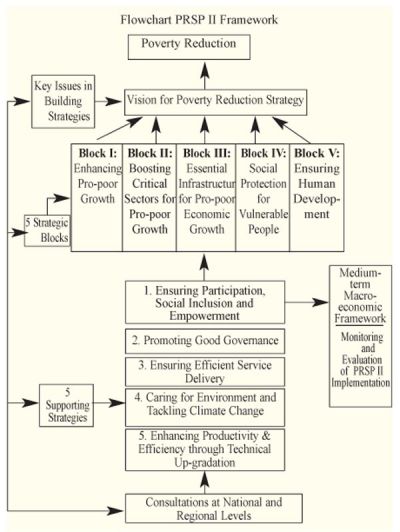Poverty Reduction Strategy Papers
Poverty Reduction Strategy Papers (PRSP) provides a framework for domestic policies and programmes to reduce purely in low-income countries, as well as for development assistance to these countries. The strategies are prepared by the countries themselves, defining their own priorities. It is also seen as Bangladesh's commitment to achieve Millennium Development Goals (MDGs) and South Asian Development Goals (SDGs) and other international agreements relevant to economic and social development.
In March 2003, Bangladesh completed its Interim Poverty Reduction Strategy (I-PRSP) known as 'A National Strategy for Economic Growth, Poverty Reduction and Social Development. It highlighted the country's effort to reduce poverty within a time-bound frame with good governance as the major building block towards reduction of poverty.
I-PRSP served as a stepping stone to further documentation of programmes and strategies with titled 'Unlocking the Potential National Strategy for Accelerated Poverty Reduction' more popularly known as PRSP, which was completed in October, 2005.
PRSP provides a vision and a framework for Poverty Reduction. It sets forth four strategic building blocks: enhancing pro-poor growth, boosting critical sectors for pro-poor economic growth, devising effective safety nets and targeted programmes and ensuring social development. It also includes four supporting strategies: ensuring participation, social inclusion and empowerment, promoting good governance, providing service delivery, caring for environment and sustainable development.
In October 2008, the task of updating the earlier document of 2005 was completed. Perceived as a measure of policy continuity, the document is titled 'Moving Ahead National Strategy for Accelerated Poverty Reduction II (FY 2009-11).'
The document is officially claimed to be a comprehensive medium-term strategy for poverty reduction. The framework and structure of PRSP II is shown below:

It is seen from the above figure that, unlike the preceding document, it outlines five instead of four strategic blocks. The addition is ensuring human development. In the same way, it uses five instead of four supporting strategies. The fifth one is enhancing productivity and efficiency through technical up gradation.
PRSP II also emphasises on strategies to deal with issues like food security and climate change which became issues of global as well as regional concerns in the context of rising food prices and natural calamities. The global rise in food prices in 2007-08 has been due to, among others, diversion of food grains to bio-fuel production and adverse impact of climate change. This led some rice-exporting countries to formally increase export price of rice followed by suspension of export. These measures impacted severely on poverty reduction effort in Bangladesh. It is estimated that 'upto about 8.5% of households have perhaps experienced income erosion (mainly from rising food prices) to the extent that they have fallen below poverty line.'
Recognizing that climate change a significant threat to fight against poverty, PRSP II puts emphasis on mainstreaming and strengthening climate change adaptation across various sectors. The government has already set up a Climate Change Fund with its own resources. A multi-donor trust fund is also being set up.
The success of implementation of the programme is contingent on the action plans of different ministries/divisions of the government as well as the private sector.
The fate of PRSP II completed in 2008 appears somewhat uncertain in view of the coming into power of a newly elected government in January 2008. Already, it has been indicated by some government leaders that PRSP II may have to be revised. The sooner it is done, the better. [AMM Shawkat Ali]
Bibliography Government of Bangladesh, The Planning Commission, Unlocking the Potential: National Strategy for Accelerated Poverty Reduction, October 2005; Government of Bangladesh, The Planning Commission, 'Moving Ahead' National Strategy for Accelerated Poverty Reduction II (FY 2009-11), October 2008; Centre for Policy Dialogue, State of the Bangladesh Economy in FY 2007-08 and Outlook for FY 2008-09, Dhaka.
